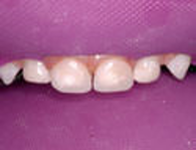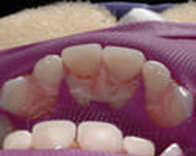Restoration (Tooth-Coloured)
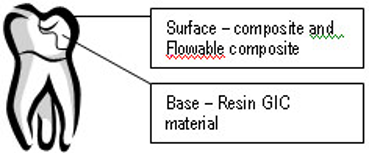
Restorations are mainly tooth-coloured which are placed in three layers for optimal aesthetics and strength.
The base of the cavity is restored with a white resin-based glass ionomer material which is cured (set) with a fast LED light, a middle layer of composite and a final surface layer of flowable composite is placed for added protection.
If local anaesthesia is required ‘The Wand™’ computerised method will be used for maximum comfort.
Fissurotomy

Where fissures are extremely deep or have signs of early decay or are stained – these pits and fissures of molars are cleaned with a microscopic fine bur, decay is removed, and the base of the pits/fissures are restored with a white filling material (different types are used depending on the most appropriate material for the situation).
The surface is then restored with a sealant or flowable composite (similar to a glaze) to increase strength and provide a smoother surface.
Step 1:
Stained and 'sticky' fissure on molar present.



Step 2:
A fissurotomy is performed which shows the extent of decay in the fissure present.
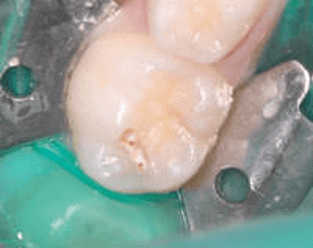
Step 3:
Finished restoration
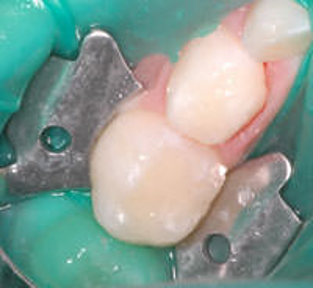
Fissure Sealant

Where fissures are moderately deep, not stained and there is no decay present – the fissure is cleaned with a fine, narrow brush, the base of the pits and fissures are sealed with a white resin-based sealant, and the remainder of the surface is restored with a flowable composite.
See Preventive Care - “Fissure Sealants” for more information.

Fissure sealant placed on the tooth.
Stainless Steel Crowns
Stainless steel crowns are used routinely by specialist paediatric dentists around the world as they are durable and have a higher success rate than white or silver fillings.
Where decay is deep or there is insufficient remaining tooth to provide support for a white restoration – a stainless steel crown may be placed on back teeth for increased protection. The crown acts like a “crash helmet” to protect the underlying weak tooth.
Once decay is removed the tooth is prepped and trimmed to specific dimensions, and a stainless steel crown adapted, tried and then cemented onto the tooth. The stainless steel crown has a 95% success rate and more durable than a white restoration.
Stainless steel crowns are placed on some baby teeth to strengthen and protect the tooth if:
- The tooth has had root canal treatment (pulpotomy)
- If there is too little tooth left after all decay has been removed to place a strong enough filling.
- Hypoplastic teeth - where the enamel has not developed properly and the teeth are weaker.
- A child with a high decay rate. The crown is the strongest material and helps seal the tooth from bacteria.
These crowns are cemented onto the tooth and naturally come out with the tooth. They still need to be cleaned and flossed properly to prevent plaque build up. Occasionally, a crown may come off (especially with trauma or if a very hard sticky food is eaten) or develop an abscess around it - so regular reviews and care are necessary.
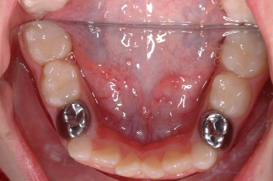
Many children are not bothered by their appearance and even proud of their smooth shiny "Batman" or Shiny "Barbie" tooth!
Anterior Strip Crowns
Anterior Strip Crowns are used to restore broken down front teeth or teeth with decay on multiple surfaces.
The crowns help ‘seal’ the underlying tooth from acid attacks and reduce the chance of developing further decay on the tooth. The crowns are made of white composite filling material. The tooth surface is prepared to specific dimensions and then the crown is carefully fitted over the existing tooth.
The success of these crowns depends on how much good tooth structure is available to place the crowns onto. If the child traumatises the teeth/crowns (falls over), there is a risk of the crown breaking or an abscess forming.
Anterior crowns need good preventive care and regular monitoring by the dentist.
Step 1:
Decayed anterior teeth in a 3 year old with a history of sipping a bottle of milk at night.
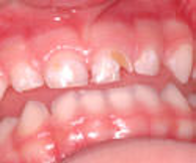

Step 2:
Once decay removed, the tooth is prepared and trimmed. Celluloid crown forms selected and adapted to fit over remaining tooth surface.
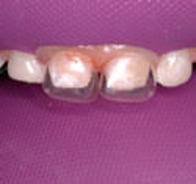
Step 3:
Composite material placed inside crown form.
The crown form is removed once the underlying composite is “set” with a curing light.
The crown form removed and composite polished.
